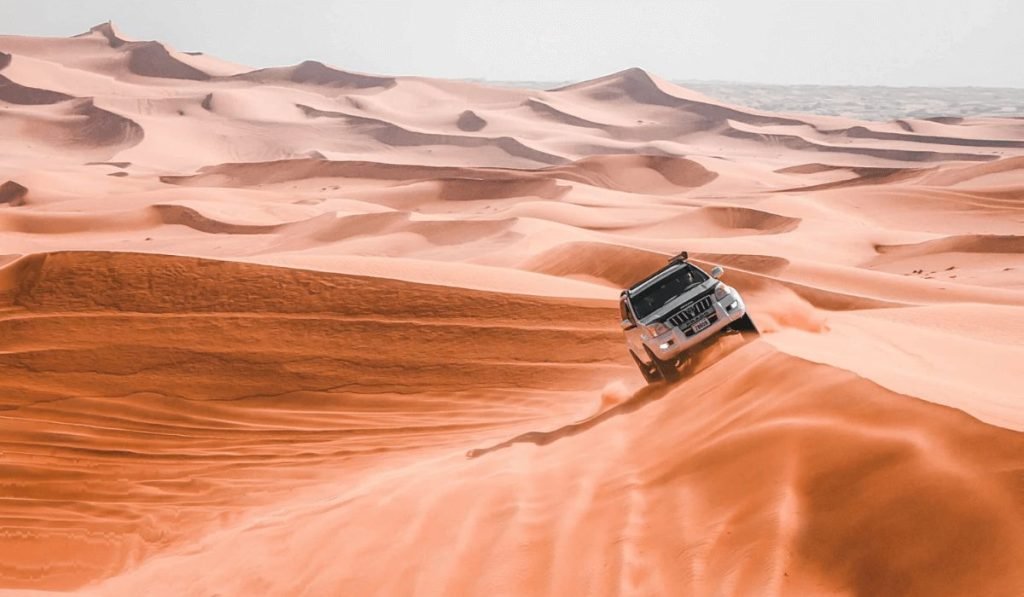Dubai is a captivating city known for its stunning architecture, luxurious lifestyle, and vibrant culture. Beyond the glitz and glamour, Dubai offers a unique desert experience through its desert safaris. These adventures allow visitors to explore the mesmerizing beauty of the desert landscape and encounter its diverse wildlife. However, it’s essential to consider the safety of both the wildlife and yourself when capturing these remarkable moments on camera.
Embarking on a Dubai desert safari is an exhilarating journey that takes you into the heart of the Arabian Desert. This vast expanse of golden sand dunes is not only a breathtaking sight but also home to a rich ecosystem that supports a surprising array of wildlife.
Understanding Dubai Desert Safari

Dubai desert safaris are popular tourist activities that provide an immersive experience in the desert environment. Tourists can choose from various safari options, including dune bashing, camel riding, sandboarding, and falconry displays. These safaris offer an opportunity to witness the unique flora and fauna that have adapted to the arid conditions of the desert.
Wildlife in Dubai Desert
Diverse Flora and Fauna
The Dubai desert is a haven for a diverse range of plant and animal species. Despite the harsh conditions, the desert ecosystem supports life through its resilient flora and adapted fauna. The flora includes desert plants such as that trees, acacia trees, and various shrubs, while the fauna comprises a remarkable variety of animals, both big and small.
Animal Species Found in Dubai Desert
The Dubai desert is home to fascinating wildlife species, including the Arabian oryx, sand gazelles, desert foxes, and various reptiles and insects. These animals have uniquely evolved to survive in the extreme desert climate, making them an integral part of the ecosystem. Capturing their beauty and behavior through photography can be an incredible experience.
The Importance of Respecting Wildlife
While photographing wildlife can be a thrilling endeavor, it’s crucial to prioritize the well-being of the animals and their habitats. Respecting wildlife means maintaining a safe distance, avoiding any actions that may disturb them, and being mindful of the fragility of their environment.
Photography and Wildlife
Photography allows us to capture the beauty of nature and share it with others. However, it’s essential to recognize the potential impact that photography can have on wildlife and take appropriate measures to minimize any negative effects.
Impact of Photography on Wildlife
The act of photographing wildlife can sometimes disrupt their natural behavior and habitats. Constant human presence, loud noises, and intrusive actions can cause stress, alter migration patterns, or even push animals away from their feeding or breeding grounds. As responsible photographers, it is our duty to mitigate these risks and protect the wildlife we admire.
Ethical Guidelines for Wildlife Photography
To ensure the safety of wildlife and maintain ethical practices, several guidelines can be followed. First, it’s essential to prioritize the welfare of the animals over getting the perfect shot. This means not approaching too closely, avoiding sudden movements or loud noises, and refraining from any behavior that may distress or endanger the animals.
Secondly, respecting their natural habitat is crucial. As photographers, we should stay on designated paths or areas to minimize any potential damage to the environment. Stepping off trails or trampling vegetation can disrupt the delicate balance of the ecosystem.
Thirdly, it’s important to remember that wildlife photography should be non-invasive. Using telephoto lenses allows us to capture intimate moments without disturbing the animals. By maintaining a safe distance, we can observe their natural behavior while minimizing any potential harm.
Safety Considerations for Wildlife Photography
When it comes to wildlife photography during a Dubai desert safari, there are specific safety considerations that should be taken into account to ensure both the photographer’s and the animal’s well-being.
Respect Distance and Habitat
Always maintain a respectful distance from the wildlife, as getting too close can cause stress or provoke defensive behavior. This not only ensures your safety but also preserves the natural behavior and comfort of the animals. Remember, capturing a great photograph should never come at the expense of the animal’s welfare.
Use Telephoto Lenses
Telephoto lenses are a valuable tool for wildlife photography as they allow you to capture detailed shots from a safe distance. These lenses have a longer focal length, enabling you to zoom in and capture stunning close-ups without disturbing the animals. Invest in quality equipment to ensure clear and sharp images.
Avoid Disturbing Wildlife
While it’s tempting to try and capture wildlife in action, it’s crucial to resist the urge to provoke or disturb them for the sake of a photograph. Avoid making sudden movements, loud noises, or using flash photography, as these can startle or stress the animals. Remember, we are visitors in their habitat, and respecting their space is of utmost importance.
Desert Safari and Wildlife Photography
Desert safari operators play a vital role in preserving wildlife and promoting responsible photography practices. Many operators have adopted measures to minimize the impact of tourism on the environment and wildlife. They provide educational materials and guidelines to ensure visitors understand the importance of respecting wildlife and their natural habitats.
During a desert safari, you may have the opportunity to capture incredible moments of wildlife in their natural surroundings. From spotting a majestic Arabian oryx gracefully moving across the dunes to observing the agile movements of a sand gazelle, the desert offers unique wildlife photography opportunities.
Conclusion
In conclusion, taking pictures of wildlife during a Dubai desert safari can be a thrilling and rewarding experience. However, it’s crucial to prioritize the safety and well-being of the animals and their habitats. Respecting wildlife, following ethical guidelines, and maintaining a safe distance are essential practices for responsible wildlife photography. By adhering to these principles, we can capture the beauty of wildlife while ensuring their preservation for generations to come.

